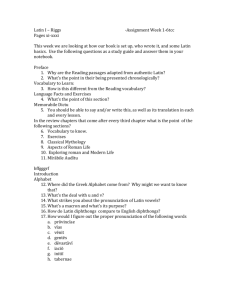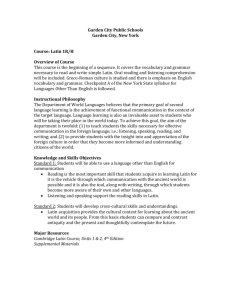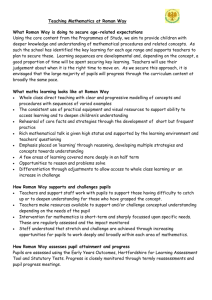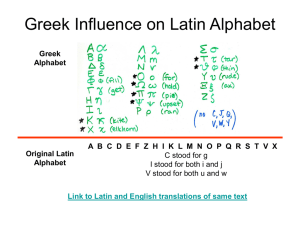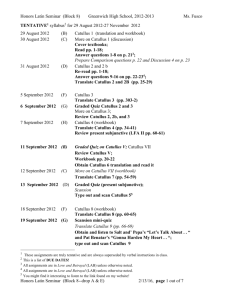Pompeii_eps - Cambridge School Classics Project
advertisement
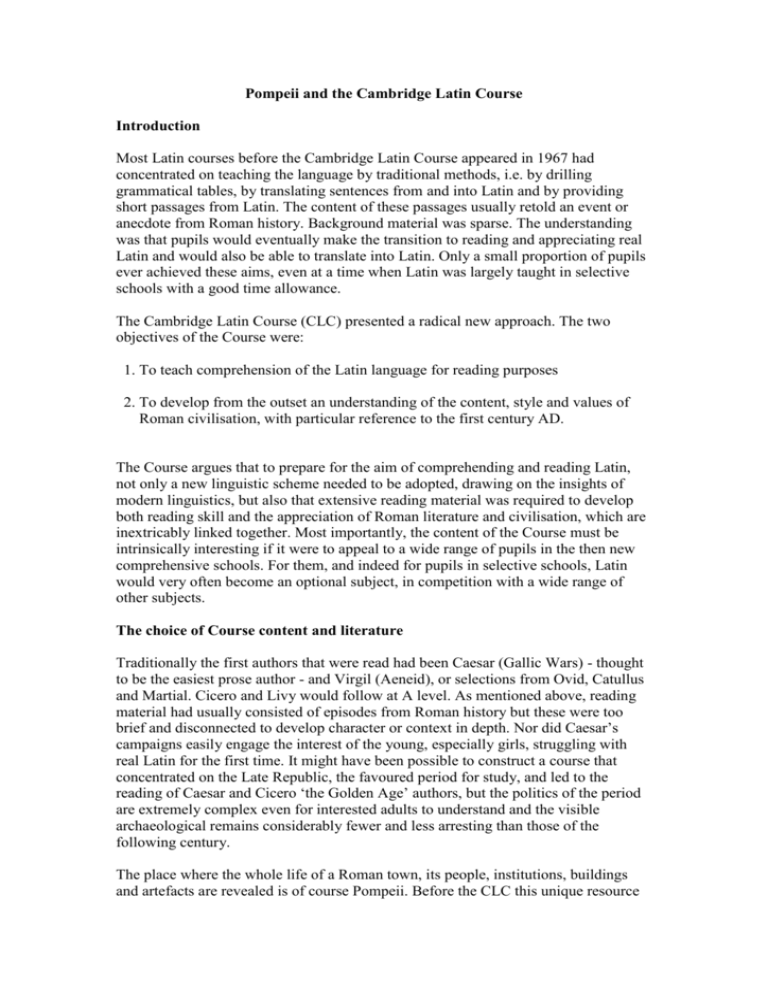
Pompeii and the Cambridge Latin Course Introduction Most Latin courses before the Cambridge Latin Course appeared in 1967 had concentrated on teaching the language by traditional methods, i.e. by drilling grammatical tables, by translating sentences from and into Latin and by providing short passages from Latin. The content of these passages usually retold an event or anecdote from Roman history. Background material was sparse. The understanding was that pupils would eventually make the transition to reading and appreciating real Latin and would also be able to translate into Latin. Only a small proportion of pupils ever achieved these aims, even at a time when Latin was largely taught in selective schools with a good time allowance. The Cambridge Latin Course (CLC) presented a radical new approach. The two objectives of the Course were: 1. To teach comprehension of the Latin language for reading purposes 2. To develop from the outset an understanding of the content, style and values of Roman civilisation, with particular reference to the first century AD. The Course argues that to prepare for the aim of comprehending and reading Latin, not only a new linguistic scheme needed to be adopted, drawing on the insights of modern linguistics, but also that extensive reading material was required to develop both reading skill and the appreciation of Roman literature and civilisation, which are inextricably linked together. Most importantly, the content of the Course must be intrinsically interesting if it were to appeal to a wide range of pupils in the then new comprehensive schools. For them, and indeed for pupils in selective schools, Latin would very often become an optional subject, in competition with a wide range of other subjects. The choice of Course content and literature Traditionally the first authors that were read had been Caesar (Gallic Wars) - thought to be the easiest prose author - and Virgil (Aeneid), or selections from Ovid, Catullus and Martial. Cicero and Livy would follow at A level. As mentioned above, reading material had usually consisted of episodes from Roman history but these were too brief and disconnected to develop character or context in depth. Nor did Caesar’s campaigns easily engage the interest of the young, especially girls, struggling with real Latin for the first time. It might have been possible to construct a course that concentrated on the Late Republic, the favoured period for study, and led to the reading of Caesar and Cicero ‘the Golden Age’ authors, but the politics of the period are extremely complex even for interested adults to understand and the visible archaeological remains considerably fewer and less arresting than those of the following century. The place where the whole life of a Roman town, its people, institutions, buildings and artefacts are revealed is of course Pompeii. Before the CLC this unique resource had hardly been used in school textbooks, because of their concentration on the earlier history of Rome and the ‘Golden Age’ authors. Pompeii offered the opportunity of a rich and detailed narrative, which would culminate in one of the most dramatic and catastrophic events in history – the eruption of Vesuvius. (As the climax of the first book of the Course, the eruption had also the practical advantage of enabling the writers to dispose of characters who would not be required in the later books of the Course.) With such a resource it would be difficult not to engage the interest of pupils. The history of the first century AD was also much less complex for pupils to understand, since Rome was under the rule of one man, the Emperor. At the same time such an autocracy raises important topics for discussion, not least the rule of despots today. In their selection of content the writers were also able to prepare pupils for the discussion of themes and characterisation they would meet later in the course and in Latin literature. The literature would mainly be that of the first century AD, Pliny and Tacitus (adapted) in prose, while the same poets as before would continue to be set. Virgil and Ovid belong more to the early Empire than the Republic, Martial to the first century AD, but the overriding reason for reading them, with Catullus, is their quality as poets. Why does the Pompeian material interest pupils? First and foremost it provides interesting historic characters living lives for which the material evidence survives. For example, we know that Caecilius, the paterfamilias of Book I, was an auctioneer, tax-collector, farmer and money–lender, because we have records of his accounts; his house has been excavated and a portrait bust discovered. The Project writers were thus able to construct a narrative about Caecilius which tries not to distort the known facts about him, although he is given an invented household, which includes a son, Quintus. As we explore the various aspects of life in Pompeii, we meet other characters, some authentic, others fictitious, but operating in a material world, of which a large part still survives: the streets, forum, law court, theatre, baths, etc. Copious illustrations (many now in colour) and written material in English supplement the narrative. The popularity of this book and the Course as a whole is due to the elements that form the constituents of the best radio and TV soaps or serials, i.e. interesting characters that the audience can identify with or love to hate, that appear often; dramatic incidents; a strong background. Developing an understanding of Roman civilisation and literature From the previous paragraph it is evident that pupils become familiar with many aspects of everyday life in Pompeii. This knowledge is not restricted to facts about its institutions and practices, but also involves the beliefs, ideas and values underlying them. This is not only valuable in itself, but is also essential preparation for the reading of the authors. For example, if one comes to Virgil with no understanding of Roman religious beliefs or to Pliny without being familiar with the system of patronage that permeated Roman society, then one is in for a bewildering time, compounded by the difficulties of the language. Again, if pupils have never met interesting characters in their course and never been able to question motivation and relationships, it is unlikely that they will be able to say much about the conflicting emotions described in a Catullus poem or to detect innuendo in a passage in Tacitus. Even with the limited resources of language available in the first book of the Course it is possible to start developing these necessary understandings from the outset. The later books pursue the same principles at deeper levels of sophistication and complexity, while still following the adventures of our hero, Quintus. From small town Pompeii the Course progresses to two contrasting parts of the Roman Empire, Roman Britain (Fishbourne) and Roman Egypt (Alexandria), then back to Roman Britain (Bath and Chester) and finally to Rome itself (life in the city, the Emperor and intrigues at court).


